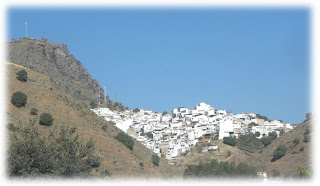Wikipedia defined Álora as a municipality in
southern Spain which
is part of the province of Malaga (Andalusia). Located near Malaga on the right bank of the river Guadalhorce. It is a typical pueblo blanco, a whitewashed village nestled
between three rocky spurs topped by the ruins of the castle.
Driving
toward Álora while in Spain,
Steven and I marveled at the panoramic view miles before we saw the first sign
pointing the way toward this ancestral village.
Knowing our great grandmother, Rosa Romero Ruiz and her parents, Miguel
Romero Fernandez and Maria Ruiz Ruiz began their lives here, we made a wrong
turn and ended up traveling along a goat trail before we realized we no longer
saw the white village in view. It was
quite a fete to find a place wide enough to turn around when the farming hills
and stone walkways rose to meet us.
Then, we met the goats when we backtracked! Hundreds of them ~
The village was
indeed white.
 It was also indeed quite
complicated to maneuver in since it was another Arabic village, twisting and
quite narrow streets that fed outward like a wheel from the congested plaza in
the center of the town.
It was also indeed quite
complicated to maneuver in since it was another Arabic village, twisting and
quite narrow streets that fed outward like a wheel from the congested plaza in
the center of the town.
Our first stop was the tourist office. This tiled sign is attached to all government buildings. When I saw it beside the door of the tourist office, I mistook it for the actual Ayuntamiento... Steven explained this phenomena to me and afterwards, I found the signs multiple times through the villages.
Armed
with my family tree and questions, a woman was eager to help but no answers
were found other than the castle, grave history and a promise to possibly find
information based on the dates I produced for her.
My paperwork/history
showed Rosa’s name, her parent’s names, her approximate date of birth and death
along with my step-grandmother’s name, Maria Carmen REY de Cordoba. My theory is the women knew one another. A widower with four children when Grandma Rosa
died, Grandpa Frank Ruiz married Maria, who had also lost her spouse. The family story states they were neighbors
in Álora but I do not have documented evidence of that fact. Maria had one child that we know of, Isobel
Fernandez. With the “Fernandez” name,
she may have been distantly related to Grandma Rosa since her father’s name was
also Fernandez. This is conjecture only.
Where is the
cemetery? We want to find gravestones of
our ancestors. Alas! No cemetery, per se, exists in Álora. In the old days, all burials were at the top
of the hill inside the old castle walls.
Bodies were cremated due to lack of space and gravestone plaques were
placed at the site only if a family purchased and delivered the plaque for the
grave site. Disappointed, we trudged
on. There was a castle to visit and photos
to take… However, after following castle
signs that led us to the central plaza for the fourth time, we chose to snap photos
from afar, knowing they were undoubtedly ‘up there somewhere.’ 

During the various
trips in and out of the village streets, we saw people everywhere, especially
around the plaza; fresh chickens were hauled by a man pushing his cart gingerly
down the street in front of us, a large truck barely scraped by us in narrow
openings beside us, children played among the adults too close to the car for
comfort. We saw beautiful metal at
windows of white houses along our route.
There were roll-down shutters on the windows and Queen Palm trees
shouldered close along the neighborhoods.
The narrow streets jutted into one another as we chicken-necked our way in
and around tiny cars parked here and there.
Overall, the village appeared quaint, clean, interesting and welcomed us
with open arms --- all except the route up to that castle!
Since my return, I
have written to the juzgado (court house) in the hope that an antique book
might have a page with the Romero Fernandez information.
Until then, we will move on to the next
village of Benagalbón Spain in my next post.















No comments:
Post a Comment